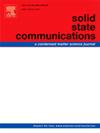Structural and optical properties of BaO-doped SiO2–B2O3–Al2O3–ZnO glasses for UV–vis applications
IF 2.4
4区 物理与天体物理
Q3 PHYSICS, CONDENSED MATTER
引用次数: 0
Abstract
The structural and optical properties of SiO2–B2O3–Al2O3–BaO/ZnO glass systems were investigated, emphasizing the effects of BaO doping for potential optical applications. The partial substitution of ZnO with BaO resulted in a density increase from 3.374 to 4.087 g/cm3. Optical absorption measurements indicated that barium ions act as network modifiers, residing near Ba2+ ions within the glass matrix. This modification led to notable structural changes, evidenced by an increase in Urbach energy (Eu) from 0.32 for ZnBa-0, 0.34 for ZnBa-1.5, 0.37 for ZnBa-3, 0.39 for ZnBa-6, to 0.42 for ZnBa-12, suggesting an enhancement in structural disorder. Additionally, a systematic decrease in both indirect () and direct () optical band gap energies was observed with rising BaO content. The decrease of from 2.68 for ZnBa-0 to 2.53 for ZnBa-1.5, to 2.43 for ZnBa-3, to 2.28 for ZnBa-6, and 2.13 for ZnBa-12, and decrease from 3.03 for ZnBa-0 to 2.86 for ZnBa-1.5, to 2.68 for ZnBa-3, to 2.56 for ZnBa-6, and 2.42 for ZnBa-12. These findings confirm the direct relationship between structural modifications, increased disorder, and altered optical properties. The BaO-doped glasses synthesized in this work demonstrate potential as bandpass filters in the (UV–Vis) spectral region.
包掺杂SiO2-B2O3-Al2O3-ZnO紫外光可见玻璃的结构和光学性质
研究了SiO2-B2O3-Al2O3-BaO /ZnO玻璃体系的结构和光学性能,强调了BaO掺杂对光学应用的影响。氧化锌被BaO部分取代后,其密度由3.374 g/cm3增加到4.087 g/cm3。光学吸收测量表明,钡离子作为网络调节剂,位于玻璃基体内Ba2+离子附近。zba -0、zba -1.5、zba -3、zba -6的乌尔巴赫能(Eu)从0.32、0.34、0.37、0.39增加到0.42,表明zba -12的结构无序性增强。此外,随着BaO含量的增加,间接(Eoptindi)和直接(Eoptdi)光学带隙能都有系统的降低。zba -0的Eoptindi从2.68降至2.53,zba -1.5降至2.43,zba -3降至2.28,zba -12降至2.13,zba -0的Eoptdi从3.03降至2.86,zba -3降至2.68,zba -6降至2.56,zba -12降至2.42。这些发现证实了结构修饰、无序增加和光学性质改变之间的直接关系。在这项工作中合成的掺宝玻璃显示了在(紫外-可见)光谱区域作为带通滤波器的潜力。
本文章由计算机程序翻译,如有差异,请以英文原文为准。
求助全文
约1分钟内获得全文
求助全文
来源期刊

Solid State Communications
物理-物理:凝聚态物理
CiteScore
3.40
自引率
4.80%
发文量
287
审稿时长
51 days
期刊介绍:
Solid State Communications is an international medium for the publication of short communications and original research articles on significant developments in condensed matter science, giving scientists immediate access to important, recently completed work. The journal publishes original experimental and theoretical research on the physical and chemical properties of solids and other condensed systems and also on their preparation. The submission of manuscripts reporting research on the basic physics of materials science and devices, as well as of state-of-the-art microstructures and nanostructures, is encouraged.
A coherent quantitative treatment emphasizing new physics is expected rather than a simple accumulation of experimental data. Consistent with these aims, the short communications should be kept concise and short, usually not longer than six printed pages. The number of figures and tables should also be kept to a minimum. Solid State Communications now also welcomes original research articles without length restrictions.
The Fast-Track section of Solid State Communications is the venue for very rapid publication of short communications on significant developments in condensed matter science. The goal is to offer the broad condensed matter community quick and immediate access to publish recently completed papers in research areas that are rapidly evolving and in which there are developments with great potential impact.
 求助内容:
求助内容: 应助结果提醒方式:
应助结果提醒方式:


